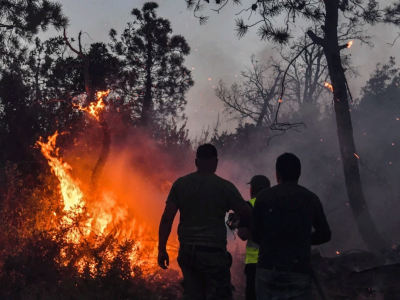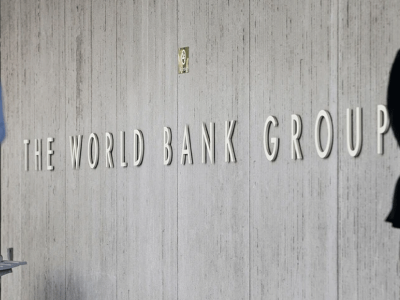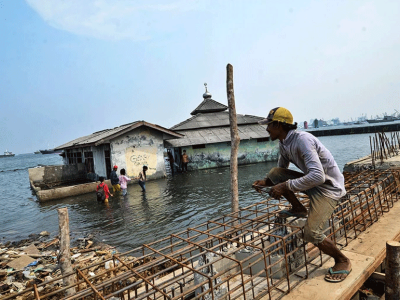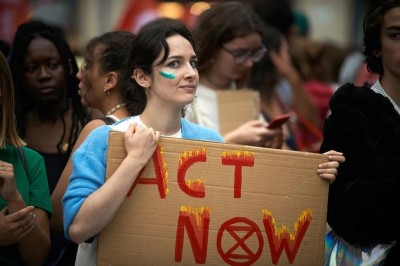Last year, countries agreed to establish a fund to address climate-related ‘loss and damage’ at the 27th United Nations Climate Change Conference (COP27) in Sharm El-Sheikh, Egypt. One year on, recommendations on the basics of the fund’s structure, governance and funding are expected to be set out at COP28 in Dubai, United Arab Emirates, at the end of this month.
It won’t be a full picture — negotiations are continuing and it will take time for the details to be worked out. Nonetheless, we argue, it’s crucial that aspects of the fund start to operate in 2024, including the release of small grants to support the most vulnerable people experiencing climate impacts.
Lessons must be drawn quickly from other areas of climate finance, too, notably the Green Climate Fund (GCF) — the world’s largest dedicated resource for supporting climate mitigation and adaptation in low-and middle-income countries (LMICs). By 1 November, the GCF had allocated US$13.5 billion to 243 projects since it was established in 2010.
But it hasn’t been all smooth sailing: the GCF has been widely criticized for being too slow, difficult to access and risk averse. On average, the fund takes more than two years to approve projects; one-fifth of the projects take 3–5 years. By contrast, humanitarian organizations such as the International Federation of Red Cross and Red Crescent Movement respond in hours to disasters such as the massive flood in September that hit the port city of Derna in Libya.
Climate loss-and-damage funding: a mechanism to make it work
Similarly, climate loss-and-damage funding must be quick and easy for anyone to access — not just governments, but also cities and community groups. That’s not the case for the GCF: more than three-quarters of its projects are led by large international organizations such as the United Nations Development Programme and the World Bank. The GCF took five years to get established, and a further year to release its first funds, because of the complex way it operates. So far, just 28% ($3.8 billion) of its committed funding has been disbursed. The loss-and-damage fund must not fall into those same traps.
Here we outline four recommendations for how the loss-and-damage fund should operate. These are grounded in principles of climate justice1 and include lessons from the GCF — specifically, from the deliberations of 15 GCF board meetings covering 181 projects between 2016 and 2021, survey responses from 42 applicants to the fund, and other publicly available data on the fund’s portfolio of projects and proposals.
Release funding quickly and easily
Speed and agility are key to the loss-and-damage fund’s success. Organizers should focus on three areas: getting the fund up and running quickly, expanding access and making applications straightforward.
First, to get going, an initial call for proposals should be developed for disbursing small grants of $50,000–100,000 by the end of 2024. Simple rules for accessing those funds should be developed in consultation with countries, civil society organizations and other stakeholders.
In our view, the loss-and-damage fund should adopt a learning-by-doing approach, with initial allocations treated as experiments, demonstrations or pilots. The fund should work with researchers and community-based organizations to document experiences — such as how the money was spent and how effective the measures were. The goal should be to deepen knowledge about how to address loss and damage effectively. Further complexities, such as larger awards and alternative forms of financing, can be added later.
‘Loss and damage’ – the most controversial words in climate finance today
Second, a wider range of organizations beyond governments, including non-governmental organizations (NGOs), grassroots organizations and local communities, need to be able to access loss-and-damage funds. Climate outcomes are stronger when communities are involved in decision-making and responsible for their own adaptation2. For example, in one mangrove-forest restoration scheme in Vietnam, community engagement led to a mangrove survival rate of 70–90% over 3 years, higher than earlier projects achieved in the same area3.
Accreditation processes should not be overly bureaucratic. To start with, for example, national governments could nominate eligible organizations to access support from the fund. By contrast, the lengthy processes used by the GCF can take years and require resources that many groups do not have — such as three years of audited accounts and evidence of past experience managing similar projects. If they do not have enough information to apply, many LMICs and sub-national groups are effectively shut out of the GCF.
Third, loss-and-damage funding requests must be simple to make and quick to assess. Processes will need to be developed for the fund to be able to respond to different types of event. Finance for rapid-onset events could be triggered by a disaster, whereas slow-onset events (such as sea-level rise) might be better addressed through long-term planning. Mechanisms must also be designed for dealing with non-economic losses and damages, such as to peoples’ health, mobility, local knowledge and cultural heritage, as well as to biodiversity. For example, funding could support the collection of oral histories and documentation of traditional knowledge to memorialize cultural heritage that is in danger of being lost.
Such processes might be modelled on the Global Environment Facility’s small-grants programme, which has given out $725 million to more than 26,000 projects since it began in 1992. Lessons can also be drawn from the Climate Justice Resilience Fund, the director of which had authority in an initial round to approve funding at levels below $100,000 without going through a full board review and approval process. The loss-and-damage fund could similarly appoint people to approve small proposals and rotate these positions every two years to avoid bias.
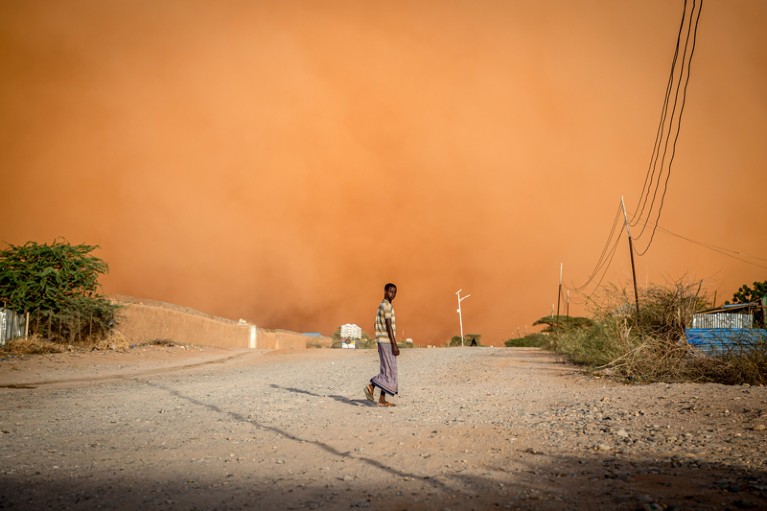
People in Somalia have been displaced because of extreme drought conditions.Credit: Sally Hayden/SOPA Images/LightRocket via Getty
Applicants should also be able to get funds pre-approved for specific purposes, such as cash transfers to people forced to relocate after a flood. Bangladesh, for example, receives anticipatory cash transfers from the UN World Food Program. These transfers have enabled livestock owners to purchase fodder for their animals in advance of a monsoon without having to sell their assets (see go.nature.com/3sy54cx).
As the loss-and-damage fund grows, it should ensure that proposals do not require overly sophisticated data or complex justifications. For example, GCF proposals need to use local climate projections to demonstrate the ‘climate rationale’ of the project, as well as calculations of the economic viability, a clear theory of change, a risk analysis and evidence and indicators of contributions to sustainability. The GCF can take months to provide feedback on proposals, and it might ask for new studies or data to be collected, resulting in delays and even in proposals being abandoned.
By contrast, Bangladesh’s government, as part of its Standing Orders on Disaster, uses a one-page ‘SOS form’ in the initial hours after a disaster to approximate losses and damages and judge emergency-response needs. Detailed assessments are conducted within three weeks using a further simple form.
The fund should use clear, simple language in its proposal requests; technical language can be a barrier. What exactly is required to demonstrate the ‘paradigm shift potential’ of a GCF project, for example? Even members of the GCF board have admitted not knowing.
Give support according to need, not bankability
Principles of climate justice, rather than of banking, should guide decisions. Funding should be distributed on the basis of need, vulnerability and human rights, and not the efficiency of spending or the ability of a project to attract finance or returns — which loss and damage is unlikely to generate.
Yet, bankability permeates the discourse on climate finance. For example, in GCF board deliberations, more than half of concerns raised by members from high-income countries (HICs) were about the optimal use of funds and the economic efficiency of projects.
Ensuring that financial mechanisms do not cause harm should be a top priority for the loss-and-damage fund. It should refrain from offering loans or other instruments that could increase the debt or exposure to financial volatility of countries that are already highly indebted. Yet, between 2016 and 2020, 72% of all climate finance was in the form of loans4.
Rich countries fall short on climate aid for poor nations
Similarly, insurance-based mechanisms for loss and damage should be framed around the principles of mutuality, solidarity and accountability5. People who are vulnerable often cannot afford to pay for insurance. And insurers might set a high bar for triggering a payment, leaving people unable to claim in the aftermath of a disaster. One approach, suggested in 1991 by the organization Alliance of Small Island States (AOSIS), proposed setting up an insurance pool supported by HICs to compensate small islands and low-lying LMICs for climate impacts6.
Co-financing — extra finance provided by other institutions to support a project — should also not be a condition for funding, because it would limit which types of loss and damage receive support. Again, this differs from the GCF, which seeks to mobilize further funding for climate action, often from the private sector.
Define eligibility broadly to claim support
The fund will not be able to cover all losses and damages, which might amount to more than $435 billion by 2030 and $1 trillion by 2050 for LMICs (see go.nature.com/3fpzmqm). Guidance on what and who the fund can support is crucial, to ensure that expectations are set appropriately, the process is transparent and applicants do not waste time, energy and capital making requests that cannot be financed.
Yet, the fund must not restrict eligibility too tightly. Defining vulnerability in practice is not straightforward7. The GCF, for example, has designated that half of adaptation funding should go to small-island developing states, least-developed countries and African countries. The loss-and-damage fund could have similar priorities, but it also needs to ensure that funding is available for other LMICs. For example, Pakistan’s 2022 floods would not have qualified for funding if only countries that were designated as particularly vulnerable by the GCF were eligible.
The loss-and-damage fund should also avoid another issue that has plagued adaptation projects in the GCF: the need to demonstrate ‘additionality’. That is, separating climate change from development and to fund only the climate portion, which is challenging8. As one survey respondent articulated: “For a small island developing state, ‘development’ and ‘climate change’ has become a consolidated and integrated approach by the necessity of its small population and dispersed isolated geography.”
Protect the ‘right to science’ for people and the planet
Vulnerability is multifaceted and such reductionist approaches do not account for social drivers such as poverty and social exclusion9. Relying on climate attribution analyses, which study whether human influence might have contributed to extreme climate events, are limited to physical impacts and are complicated to produce, and would cause similar issues.
We recommend that the fund embrace the principles of locally led adaptation and enable recipients to articulate their needs on their own terms. This has never been done before, so it is impossible to pre-define what this will look like, but a commitment to community engagement and collaboration, risk-taking and an appetite for learning from mistakes will be key.
Equal representation by LMICs and HICs is a core principle of the UN Framework Convention on Climate Change (UNFCCC) and must underpin the loss-and-damage fund. At a minimum, the composition of the fund’s board needs to be balanced. But extra steps are also needed to achieve equitable participation by people in LMICs.
A consensus should not be required for decisions. The UNFCCC often depends on one when approving decisions. However, that leads to delay and enables any one board member to block decisions. In our view, the loss-and-damage fund should stipulate that if the board fails to reach consensus, a two-thirds majority can approve any funding decision.
Put LMICs at the centre
Equal representation does not necessarily ensure equal participation in shaping funding decisions, as the GCF shows. Its board consists of 12 members from LMICs, the same number from HICs, and 4 observers from civil society and the private sector. Yet, in the 181 proposal deliberations we examined, HIC board members had more critiques of proposals than did those from LMICs (409 and 147 concerns, respectively). And more time was spent discussing the critiques from HICs.
The concerns of HICs and LMICs differed — HICs were more concerned about the oversight of funds, whereas LMICs were concerned with equitable access to funds. The former focused on how compelling the climate rationale was, whether funds were being used optimally and how well investment criteria were explained. The latter raised more concerns about whether a proposal would cause further risk and harm and how inclusive its development process was10.
Civil-society participation needs to be given greater authority. In the GCF deliberations, observers drew attention to human-rights and gender concerns, such as weak gender integration in implementation plans and possibilities of labour violations. They also spotted problems — for example, the GCF rules do not explicitly prevent the funding of fossil fuels.
Earth’s average 2023 temperature is now likely to reach 1.5 °C of warming
Yet, although the observers were vocal (expressing 461 concerns), their points were rarely incorporated into final board decisions. Of the 181 projects, the board attached conditions to 49 before approval. Of these, only 14 included conditions that were based on the concerns raised by civil society. By contrast, all 49 projects included conditions raised by HIC board members.
Therefore, we suggest, if the loss-and-damage fund has a 24-member board, it should include 12 members from LMICs, 8 members from HICs, and 4 members from civil society, including representatives of Indigenous groups and young people. The fund should also develop guidance on approaches that are not permissible, such as funding fossil fuels.
Last words
Realizing the loss-and-damage fund will help billions of people around the world to cope with the inevitable impacts of climate change. It would also honour the legacy of our esteemed colleague, mentor and co-author of this paper, Saleemul Huq, who spent decades championing the creation of an effective and equitable loss-and-damage fund, and who died suddenly on 28 October 2023.
